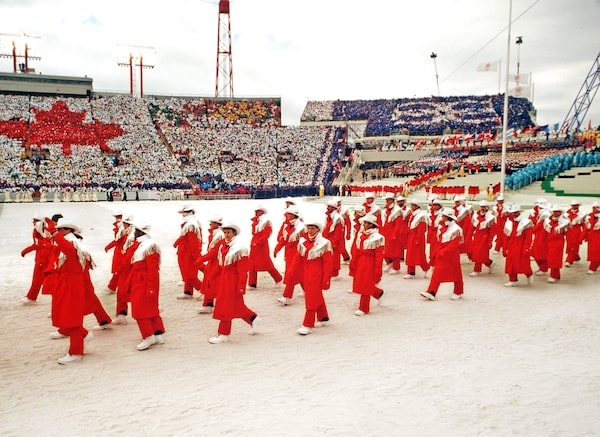
Calgary previously hosted the Olympics in 1988 and, in the process, transformed the way the Winter Games are staged, turning a profit on record TV revenue and leveraging lucrative sponsorship opportunities as never before.T. O'lett/COC/The Canadian Press
As Olympic proposals go, the plan unveiled this week by the Calgary 2026 committee could generously be described as prudent and responsible. Boring and utterly lacking in ambition might be terms others would use.
That, of course, is the thing about these bids: They are all in the eye of the beholder. Where one person views the Olympic Games as an opportunity to lift a city and a nation, another can’t get beyond regarding them as an unnecessary evil imbued with enormous financial risk.
On Tuesday, Calgary City Council endorsed the committee’s $5.2-billion blueprint, which clears the way for a yea-or-nay non-binding plebiscite on the matter in November. Prior to then, the bid committee will attempt to sell the Calgary public on the merits of its proposal, which calls for the construction of two new medium-sized sport venues and the rehabilitation of 11 existing ones, the majority of which were used when the city hosted the Winter Olympics in 1988. (It’s the Renovation Games!)
Conspicuous in its absence was any mention of a new arena to host hockey and figure skating – the two marquee events of any Winter Games. Instead, it calls for the rusting hulk of the Calgary Saddledome to be rehabilitated. Many will be disappointed with that, but a new arena was never going to be in the plans without ownership of the NHL Calgary Flames, the building’s main tenant, financing the bulk of those costs. On that front, the organization and the city remain at odds over various demands the hockey team is making, including major tax concessions.
Of course, we are a long way from any of this coming to fruition. Even though the referendum in November is non-binding, it will go a long way toward determining whether the city goes ahead with its submission. A split vote would not be great, and that is always the potential hazard with these things. When then-Vancouver mayor Larry Campbell announced there would be a plebiscite on the Vancouver Olympic proposal, many thought it would be the project’s death knell. But when 64 per cent voted in favour, it actually helped the bid in the eyes of the International Olympic Committee.
But even if Calgary 2026 chief executive Mary Moran and her team sell the city on the project, she then needs to sell the IOC and people across the country as well. As much as anything, this was maybe the most important element of John Furlong’s stint as head of the 2010 Games in Vancouver – selling a vision. He believes that Calgary has the potential to relay a powerful story to the rest of the world.
“I think there is also a real opportunity here to refocus Alberta,” Mr. Furlong told me over the phone from Ireland. “It’s been a province reliant on one industry. The Olympics could possibly change that, give people a sense of what’s possible going forward.
“The Olympic Games are a massive marketing opportunity, a powerful message centre. It could open the province up to new ideas and a new way forward, I think.”
Should Calgary decide to go ahead, its two biggest competitors are likely to be Sweden (Stockholm) and Italy (Milan). Sweden has bid seven times and never won. The country’s due. Milan, meantime, has a powerful brand. But Calgary does have one massive trump card: The city has done it before and, in the process, very much transformed the way the Winter Games are staged, turning a profit on record TV revenue and leveraging lucrative sponsorship opportunities as never before.
The biggest negative of the Calgary plan, in my view, is the idea of holding the ski jump at Whistler, a thousand kilometres from what would be the heart of the Games. Some Winter Olympic venues can be a couple of hours from the centre of the action, but not 10. It’s as if Sweden proposed to hold their ski jump in Germany. And then you have the fact that one of the great cultural holdovers from the 1988 Games was Eddie the Eagle, the bespectacled English ski jumper who stole the show 30 years ago. How can you not trade on that?
That said, Calgary has two of the most important assets needed to launch a competitive offer: It’s one of the most livable places in the world and inhabited by incredibly hard-working people with a can-do spirit. Early signs point to a city, and province, eager to show what they did before so convincingly, they can do again.
 Gary Mason
Gary Mason